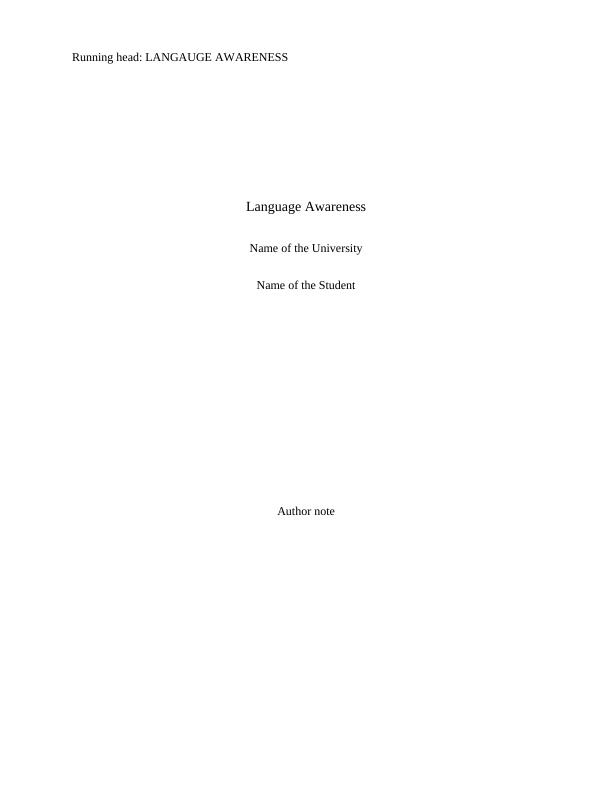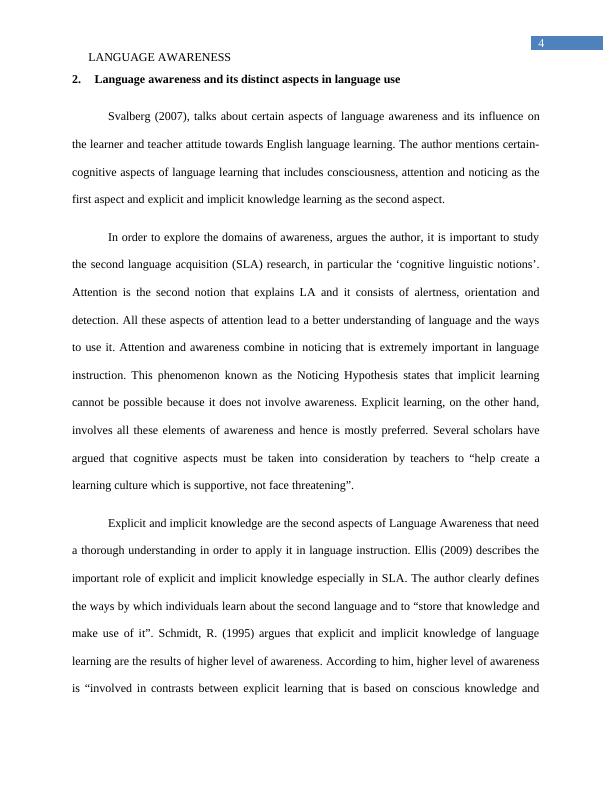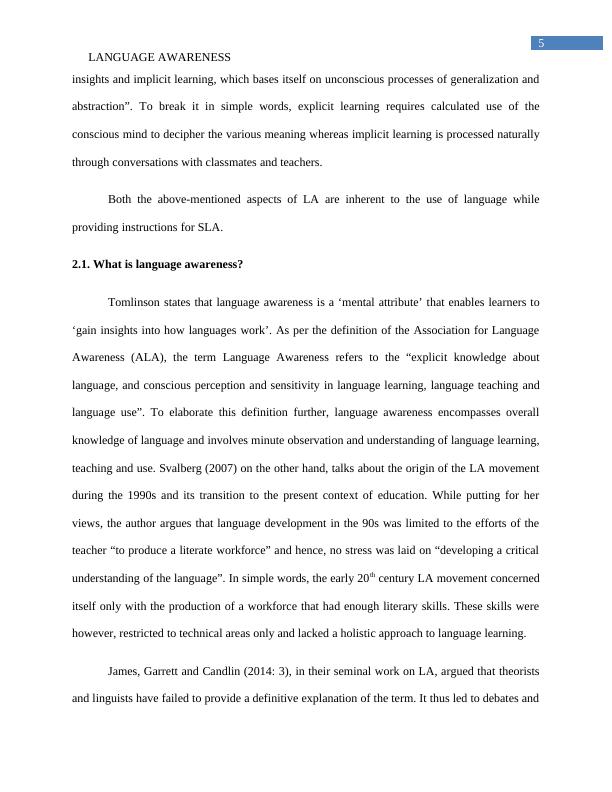Ask a question from expert
Language Awareness Assignment
22 Pages5844 Words118 Views
Added on 2020-04-21
Language Awareness Assignment
Added on 2020-04-21
BookmarkShareRelated Documents
Running head: LANGAUGE AWARENESSLanguage AwarenessName of the UniversityName of the StudentAuthor note

1LANGUAGE AWARENESSTable of Contents1.Introduction..............................................................................................................................22.Language awareness and its distinct aspects in language use..................................................32.1. What is language awareness?...............................................................................................42.2. Aspects that affect English language in use.........................................................................52.2.1. Context...............................................................................................................................62.2.2. Medium..............................................................................................................................62.2.3. Users..................................................................................................................................73. English grammar variation in language use.................................................................................83.1. With Children...........................................................................................................................83.2. With Adults...............................................................................................................................93.3. Saudi English learners............................................................................................................104. Reflection of own language awareness as a learner and a teacher............................................125. Conclusion.................................................................................................................................13Bibliography:.................................................................................................................................15Appendices:...................................................................................................................................18Appendix A................................................................................................................................18Appendix B................................................................................................................................19

2LANGUAGE AWARENESS

3LANGUAGE AWARENESS1.IntroductionIn teacher education concerning Teaching English to Speakers of Other Languages(TESOL), Language awareness is a commonly used term that often refers to the skills toteachers-in-training on LA mainly within the classroom (Ellis, 2012). Attaining awareness aboutlanguage requires teachers to first understand the very essence of language. Andrews (2006),states, “language is patently important” to human beings. Without language, there can be noscope for communication. A deep understanding of language comes from having awarenessabout the language.Ronald (2003: 64) defines language awareness as “development in learnersof an enhanced consciousness of and sensitivity to the forms and functions of language”.The‘forms and functions’ of language refer to the technicalities that are present in learning language.The author further states that this approach of language awareness “has been developed incontexts of both second and foreign language learning”. Language awareness combines content,language skill, attitudinal education and meta-cognitive prospects enabling students to mirror theprocess of language acquirement, learning and use.Classrooms centered on students andassistance available to teachers in teaching English has been created in the modern day owing tothe focus on language awareness. In this paper, I will explore the theoretical examination of LA and its significance indeveloping teachers’ ability to teach the students of King Saud University (KSU), Saudi Arabia.Further, I will present ideas about the influence of different features of language awareness onthe application of grammar. In addition, I will discuss the function of English in the teachers’context. I will explain the manifestation of language awareness as both a learner and a teacher inthis paper. Ideas and concepts culminated from the evaluation would be presented as suggestionsand recommendations for teachers to pursue LA in order to achieve ELT competence.

4LANGUAGE AWARENESS2.Language awareness and its distinct aspects in language useSvalberg (2007), talks about certain aspects of language awareness and its influence onthe learner and teacher attitude towards English language learning. The author mentions certain-cognitive aspects of language learning that includes consciousness, attention and noticing as thefirst aspect and explicit and implicit knowledge learning as the second aspect. In order to explore the domains of awareness, argues the author, it is important to studythe second language acquisition (SLA) research, in particular the ‘cognitive linguistic notions’.Attention is the second notion that explains LA and it consists of alertness, orientation anddetection. All these aspects of attention lead to a better understanding of language and the waysto use it. Attention and awareness combine in noticing that is extremely important in languageinstruction. This phenomenon known as the Noticing Hypothesis states that implicit learningcannot be possible because it does not involve awareness. Explicit learning, on the other hand,involves all these elements of awareness and hence is mostly preferred. Several scholars haveargued that cognitive aspects must be taken into consideration by teachers to “help create alearning culture which is supportive, not face threatening”. Explicit and implicit knowledge are the second aspects of Language Awareness that needa thorough understanding in order to apply it in language instruction. Ellis (2009) describes theimportant role of explicit and implicit knowledge especially in SLA. The author clearly definesthe ways by which individuals learn about the second language and to “store that knowledge andmake use of it”. Schmidt, R. (1995) argues that explicit and implicit knowledge of languagelearning are the results of higher level of awareness. According to him, higher level of awarenessis “involved in contrasts between explicit learning that is based on conscious knowledge and

5LANGUAGE AWARENESSinsights and implicit learning, which bases itself on unconscious processes of generalization andabstraction”. To break it in simple words, explicit learning requires calculated use of theconscious mind to decipher the various meaning whereas implicit learning is processed naturallythrough conversations with classmates and teachers. Both the above-mentioned aspects of LA are inherent to the use of language whileproviding instructions for SLA. 2.1. What is language awareness?Tomlinson states that language awareness is a ‘mental attribute’ that enables learners to‘gain insights into how languages work’. As per the definition of the Association for LanguageAwareness (ALA), the term Language Awareness refers to the “explicit knowledge aboutlanguage, and conscious perception and sensitivity in language learning, language teaching andlanguage use”. To elaborate this definition further, language awareness encompasses overallknowledge of language and involves minute observation and understanding of language learning,teaching and use. Svalberg (2007) on the other hand, talks about the origin of the LA movementduring the 1990s and its transition to the present context of education. While putting for herviews, the author argues that language development in the 90s was limited to the efforts of theteacher “to produce a literate workforce” and hence, no stress was laid on “developing a criticalunderstanding of the language”. In simple words, the early 20th century LA movement concerneditself only with the production of a workforce that had enough literary skills. These skills werehowever, restricted to technical areas only and lacked a holistic approach to language learning. James, Garrett and Candlin (2014: 3), in their seminal work on LA, argued that theoristsand linguists have failed to provide a definitive explanation of the term. It thus led to debates and

End of preview
Want to access all the pages? Upload your documents or become a member.
Related Documents
Grammar and Teaching Communication Assignment 2022lg...
|37
|7934
|13
Assignment on Role of Authenticity of Materials and Activitieslg...
|17
|4662
|95
Critical Evaluation of a Spoken and Vocabulary Skills Material for ESL Learnerslg...
|24
|4860
|84
Teaching Practice in English Languagelg...
|16
|987
|191
Challenges Faced by English Language Learners and Teachers in ESL Classroomslg...
|14
|3546
|249
Pragmatics as a Language Learnerlg...
|4
|366
|71